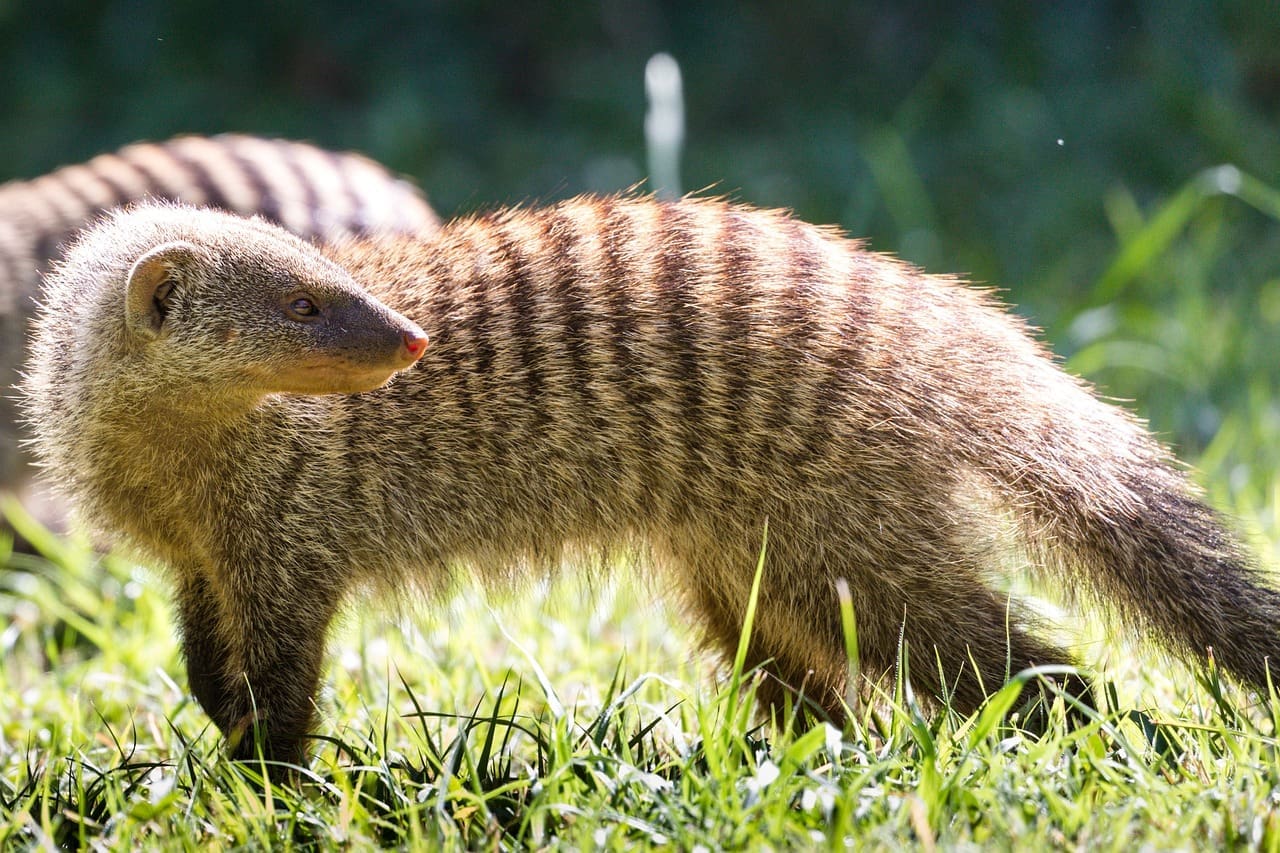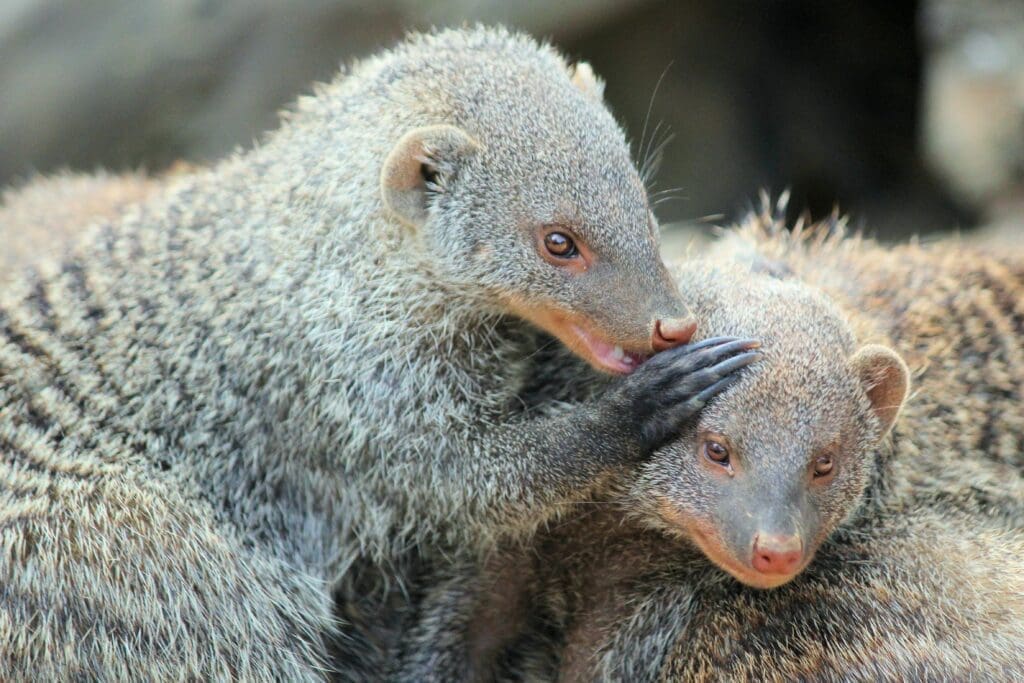Which creature enjoys social gatherings, is well adapted to its habitat, and can be very altruistic?

The Banded Mongoose is a small mammal with a mass of approximately ≤2kg (or 4 lbs) found in (and indigenous to) various parts of Africa. While most other mongoose species live a solitary life, the banded mongoose is gregarious living in groups of approximately 5-40 individuals with at least one breeding male and female. They are named so due to the black stripes across their greyish-brown dorsal area (back) while their ventral area (chest and stomach) is lighter than other parts. This species is commonly known for its ability and behavior to attack, kill, and eat snakes – even venomous ones!

Adaptation to their environment
Banded mongooses are mostly found occupying covered areas like savannahs, open forests, and grasslands for vigilance. They sleep and nurture their young in dens such as abandoned termite mounds, buildings, and even under bridges. By possessing short muscular limbs with strong claws, banded mongooses can dig to find food and get creative at creating and modifying their dens. Because they live in large groups as compared with other mongooses, their burrows have many entrances to ensure their escape during an attack and for sufficient ventilation. Despite having such nice dens, they are not sedentary to the specific den but rather frequently move from place to place every few days to avoid and distract their enemies. However, they can return to their favorite den after a certain time. In addition, their body color allows them to blend with several habitats and hence ensures their safety.

Like other animals, banded mongoose adults, especially males, are responsible for the safety of the whole group. Unlike many other animals, all adult members are fully responsible for raising their young who are born synchronously (all matured female members get pregnant and give birth at the same time). Having muscular limbs, banded mongooses can stand by using their hind limbs just like their cousins (meerkats) to ensure the area is safe.
These animals also exhibit altruistic behaviours whereby adults are ready to give up their life for the safety of the group. They were recorded standing and fighting against lions, birds of prey, and other animals, and while doing so other group members evacuated from the area. Additionally, since they are small in size, they move in groups and close to each other so that they may be seen as one large animal. And as they move, the young ones are located in the middle and the adult ones around them.
Diet and behavioral adaptation
The banded mongoose is a meso-carnivore with a diet consisting primarily of invertebrates such as beetles, millipedes, scorpions and others. Nevertheless, they also eat vertebrates such as snakes, rats, amphibians, mice, young birds and eggs. And in the case of plants, they eat wild fruits (if they’re available). Normally, they move together while locating the food area but each member finds and eats its food. In urban areas, they are mostly found around damp areas during their mealtime because there is plenty of food there, and then they rest in the covered areas mostly at noon to avoid the day heat.
On other hand, banded mongooses cope with food problems by using different symbiotic relationships with other animals like birds, warthogs (watch the video below to see this in action), elephants, and others (see more from attached YouTube links in the References). In this way, they become more successful in foraging and thriving in nature. They also use other animals, especially birds, to be alerted of various threats around them.
Though they are social animals, banded mongooses also exhibit inter-group territorial behaviour and their territories are marked with various scents, especially urine. Not only are territories scent-marked but so are group members. This is well seen when new pups are taken out for their first foraging and adults urinate over the young ones. When two different groups meet, they normally fight and the winning group takes over the area that they fought for. However, during the fight, some mature males and females from each group may mate.
Communication
Banded mongooses mainly communicate through sounds and scents. They possess various sound pitches, each with a different meaning and message to other members. They also developed anal and cheek glands which assist in the marking of their territory and young. They have a well-developed sense of smell, which they use to detect food.
Threats
Currently, banded mongooses are not faced with any critical danger and are listed as a“Least Concern” species due to their large population number and distribution in most parts of Africa. But this does not mean they don’t need any concern at all. I found some of them died in road accidents, and for those in urban areas most people used to attack them. Remember, even extinct species were once “Least Concern” and where are they now? Therefore, let’s give attention to every species in the world before their situation becomes worse.
Lesson to humanity
From such a small animal, we may think that there is nothing to gain, but there is a lot to learn from it. Banded mongooses, as said before, are ready to sacrifice their safety and even life just to make sure their groups are safe. This act shows love for others, something which nowadays very few people can do to others regardless of whether the one in need is their relative or not. I also like the way they raise their family. All group members are fully responsible for that, and if people were to do the same, there would be no street children and other problems also could be solved.
This lesson shows how we can learn from banded mongooses, but it is not just this species that we can learn things from. The whole of nature provides us with enough knowledge, materials and services that are essential for our survival. Therefore, let’s love nature and put our individual or organizational efforts into conserving it to ensure its natural existence lasts and more generations to come will continue to gain what we are gaining now.
On behalf of mongooses everywhere, thank you!
Vitalis







When I was growing up in Delhi, India in the 1940s, I was told that mongooses lived under our house and that they protected us from snakes, of which there were many, some very poisonous. All I can remember for sure is that ho one reported a snake bite.